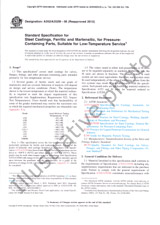We need your consent to use the individual data so that you can see information about your interests, among other things. Click "OK" to give your consent.
ASTM B387/B387M-23
Standard Specification for Molybdenum and Molybdenum Alloy Bar, Rod, and Wire
Translate name
STANDARD published on 1.1.2023
The information about the standard:
Designation standards: ASTM B387/B387M-23
Publication date standards: 1.1.2023
SKU: NS-1102233
The number of pages: 5
Approximate weight : 15 g (0.03 lbs)
Country: American technical standard
Category: Technical standards ASTM
The category - similar standards:
Annotation of standard text ASTM B387/B387M-23 :
This specification covers unalloyed molybdenum and molybdenum alloy bar, rod, and wire. The following materials are covered: molybdenum 360, molybdenum 361, molybdenum 363, molybdenum 364, molybdenum 365, and molybdenum 366. These materials shall be manufactured with conventional extrusion, forging, swaging, rolling, and drawing equipment. These shall materials be made by vacuum arc-melted or powder metallurgy methods. The chemical composition shall conform to the required contents of carbon, oxygen, nitrogen, iron, nickel, silicon, titanium, tungsten, zirconium, and molybdenum. Chemical analysis shall be done. Mechanical properties shall conform to the required tension properties: tensile strength, yield strength, elongation, and diamond pyramid hardness. Tension test shall also be done.
Keywords:
molybdenum, molybdenum alloy bar, molybdenum alloy rod, molybdenum alloy wire , molybdenum bar, molybdenum rod, molybdenum wire,, ICS Number Code 77.150.99 (Other products of non-ferrous metals)
Additional information
| 1. Scope |
|
1.1?This specification covers unalloyed molybdenum and molybdenum alloy bar, rod, and wire as follows: 1.1.1?Molybdenum 360Unalloyed vacuum arc-cast molybdenum. 1.1.2?Molybdenum 361Unalloyed powder metallurgy molybdenum. 1.1.3?Molybdenum Alloy 363Vacuum arc-cast molybdenum0.5 % titanium0.1 % zirconium (TZM) alloy. 1.1.4?Molybdenum Alloy 364Powder metallurgy molybdenum0.5 % titanium0.1 % zirconium (TZM) alloy. 1.1.5?Molybdenum 365Unalloyed vacuum arc-cast molybdenum, low carbon. 1.1.6?Molybdenum Alloy 366Vacuum arc-cast molybdenum, 30 % tungsten alloy. 1.2?This specification covers wire no smaller than 0.020 in. [0.51 mm] in diameter or of equivalent cross-sectional area. Specification F289 covers diameters up to 0.020 in. [0.51 mm]. 1.3?The values stated in either SI units or inch-pound units are to be regarded separately as standard. The values stated in each system are not necessarily exact equivalents; therefore, to ensure conformance with the standard, each system shall be used independently of the other, and values from the two systems shall not be combined. 1.4?The following precautionary caveat pertains only to the test method portions of this specification: This standard does not purport to address all of the safety concerns, if any, associated with its use. It is the responsibility of the user of this standard to establish appropriate safety, health, and environmental practices and determine the applicability of regulatory limitations prior to use. 1.5?This international standard was developed in accordance with internationally recognized principles on standardization established in the Decision on Principles for the Development of International Standards, Guides and Recommendations issued by the World Trade Organization Technical Barriers to Trade (TBT) Committee. |
We recommend:
Technical standards updating
Do you want to make sure you use only the valid technical standards?
We can offer you a solution which will provide you a monthly overview concerning the updating of standards which you use.
Would you like to know more? Look at this page.




 Cookies
Cookies
